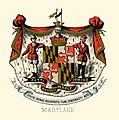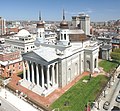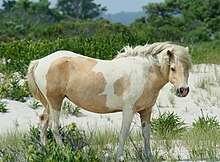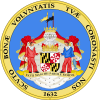Our website is made possible by displaying online advertisements to our visitors.
Please consider supporting us by disabling your ad blocker.
Portal:Maryland
|
Maryland Portal
|
Baltimore Task Force
|
Frederick Task Force
|
Montgomery Task Force
|
WikiProject Maryland
|
|
Main page
|
Discussion
|
Introduction Maryland (US: /ˈmɛrɪlənd/ MERR-il-ənd) is a state in the Mid-Atlantic region of the United States. It borders Virginia to its south, West Virginia to its west, Pennsylvania to its north, Delaware and the Atlantic Ocean to its east, and the national capital of Washington, D.C. to the southwest. With a total area of 12,407 square miles (32,130 km2), Maryland is the ninth-smallest state by land area, and its population of 6,177,224 ranks it the 19th-most populous state and the fifth-most densely populated. Maryland's capital is Annapolis, and the most populous city is Baltimore. Maryland's coastline was first explored by Europeans in the 16th century. Prior to that, it was inhabited by several Native American tribes, mostly the Algonquian peoples. As one of the original Thirteen Colonies, Maryland was founded by George Calvert, 1st Baron Baltimore, a Catholic convert who sought to provide a religious haven for Catholics persecuted in England. In 1632, Charles I of England granted Lord Baltimore a colonial charter, naming the colony after his wife, Henrietta Maria. In 1649, the Maryland General Assembly passed an Act Concerning Religion, which enshrined the principle of toleration. Religious strife was common in Maryland's early years, and Catholics remained a minority, albeit in greater numbers than in any other English colony. Maryland's early settlements and population centers clustered around waterways that empty into the Chesapeake Bay. Its economy was heavily plantation-based and centered mostly on the cultivation of tobacco. Demand for cheap labor from Maryland colonists led to the importation of numerous indentured servants and enslaved Africans. In 1760, Maryland's current boundaries took form following the settlement of a long-running border dispute with Pennsylvania. Many of its citizens played key political and military roles in the American Revolutionary War. Although it was a slave state, Maryland remained in the Union during the American Civil War, and its proximity to Washington D.C. and Virginia made it a significant strategic location. After the Civil War ended, Maryland took part in the Industrial Revolution, driven by its seaports, railroad networks, and mass immigration from Europe. Since the 1940s, the state's population has grown rapidly, to approximately six million residents, and it is among the most densely populated U.S. states. As of 2015[update], Maryland had the highest median household income of any state, owing in large part to its proximity to Washington, D.C., and a highly diversified economy spanning manufacturing, retail services, public administration, real estate, higher education, information technology, defense contracting, health care, and biotechnology. Maryland is one of the most multicultural states in the country; it is one of the six states where non-Whites compose a majority of the population, with the fifth-highest percentage of African Americans, and high numbers of residents born in Africa, Asia, Central America, and the Caribbean. The state's central role in U.S. history is reflected by its hosting of some of the highest numbers of historic landmarks per capita. (Full article...) This is a Featured article, which represents some of the best content on English Wikipedia..
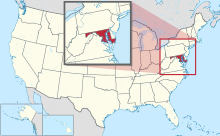 The Maryland House of Delegates is the lower house of the Maryland General Assembly, the state legislature of the U.S. State of Maryland. Three delegates are elected from each district, though some districts are divided into sub-districts. In the original state constitution, four delegates were elected from each county to one-year terms, and two were elected from each of the major early cities of Baltimore and Annapolis. Reforms in the 1830s, however, led to the apportionment of delegates by population rather than geography, and by 1922, delegates served four year terms. The modern system of apportionment of seats began in 1972, when 47 districts of roughly equal population were identified, although sub-districts were created to ensure local representation for areas with too little population to warrant an entire district. Delegates are elected in even years when the President of the United States is not being elected, similar to most other state offices in Maryland. The most recent election was in November 2022. Delegates are not term-limited. (Full article...) General imagesIn the news
On this day...October 20
This is a Good article, an article that meets a core set of high editorial standards.
The Chincoteague pony, also known as the Assateague horse, is a breed of horse that developed, and now lives, within a semi-feral or feral population on Assateague Island in the US states of Virginia and Maryland. The Chincoteague pony is one of the many breeds of feral horses in the United States. The breed was made famous by the Misty of Chincoteague novels, written by pony book author Marguerite Henry, and first published in 1947, and the pony Misty of Chincoteague. Although popularly known as Chincoteague ponies, the feral ponies live on Assateague Island. The entire island is owned by the federal government and is split by a fence at the Maryland/Virginia state line, with a herd of around 150 ponies living on the Virginia side of the fence, and 80 on the Maryland side. The herds live on land managed by two separate agencies with different management strategies. Ponies from the Maryland herd (referred to in the literature of the National Park Service as Assateague horses) live within Assateague Island National Seashore. They are generally treated as wild animals, given no more or less assistance than any other species on the island, other than contraceptive treatments to curb overpopulation. Conversely, the Virginia herd (referred to as Chincoteague ponies) lives within the Chincoteague National Wildlife Refuge, and is owned by the Chincoteague Volunteer Fire Company. The Virginia ponies are treated to twice-yearly veterinary inspections, which prepare them for life among the general equine population if they are sold at auction. While only around 300 feral ponies live on Assateague Island, around 1,000 more live off-island, having been purchased or bred by private breeders. (Full article...) Selected article -Baltimore is the most populous city in the U.S. state of Maryland. With a population of 585,708 at the 2020 census, it is the 30th-most populous US city. Baltimore was designated an independent city by the Constitution of Maryland in 1851, and is the most populous independent city in the nation. As of 2020[update], the population of the Baltimore metropolitan area was 2,838,327, the 20th-largest metropolitan area in the country. When combined the Washington–Baltimore combined statistical area (CSA) had a 2020 population of 9,973,383, the third-largest in the country. Though the city is not located within or under the administrative jurisdiction of any county in the state, it is part of the Central Maryland region, together with the surrounding county that shares its name. The land that is present-day Baltimore was used as hunting ground by Paleo-Indians. In the early 1600s, the Susquehannock began to hunt there. People from the Province of Maryland established the Port of Baltimore in 1706 to support the tobacco trade with Europe, and established the Town of Baltimore in 1729. During the American Revolutionary War, the Second Continental Congress, fleeing Philadelphia prior to its fall to British troops, moved their deliberations to Henry Fite House on West Baltimore Street from December 1776, to February 1777, permitting Baltimore to serve briefly as the nation's capital, before it returned to Philadelphia in March 1777. The Battle of Baltimore was pivotal during the War of 1812, culminating in the failed British bombardment of Fort McHenry, during which Francis Scott Key wrote a poem that would become "The Star-Spangled Banner", designated as the national anthem in 1931. During the Pratt Street Riot of 1861, the city was the site of some of the earliest violence associated with the American Civil War. (Full article...) Did you know?

SubcategoriesSelect [+] to view subcategories
TopicsRelated portalsAssociated WikimediaThe following Wikimedia Foundation sister projects provide more on this subject:
Discover Wikipedia using portals |
Previous Page Next Page














